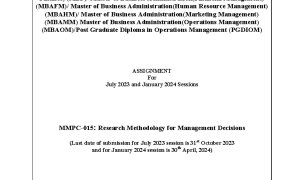| Question | Answer |
|---|---|
| What do you mean by marginal rate of substitution? Why does marginal rate of substitution of X for Y fall when quantity of X is increased? | **1. Understanding the Marginal Rate of Substitution** The Marginal Rate of Substitution (MRS) is a fundamental concept in consumer choice theory that measures the rate at which a consumer is willing to give up one good (Y) to obtain an additional unit of another good (X) while maintaining the same level of utility (satisfaction). Mathematically, it is the slope of the indifference curve at any given point and is expressed as: \[ MRS_{XY} = -\frac{\Delta Y}{\Delta X} \] The negative sign indicates the trade-off between the two goods—consumers must sacrifice some quantity of Y to gain more of X without changing their overall satisfaction. **2. Why the MRS of X for Y Diminishes as X Increases** The principle of **Diminishing Marginal Rate of Substitution** states that as a consumer acquires more of good X, the willingness to give up good Y for additional units of X decreases. This occurs due to two key economic behaviors: - **Diminishing Marginal Utility:** As consumption of X increases, the additional satisfaction (marginal utility) derived from each extra unit of X declines. Consequently, the consumer is less inclined to sacrifice large amounts of Y to obtain more X, reducing the MRS. - **Relative Scarcity and Preferences:** When a consumer has little of X and much of Y, they highly value X and are willing to trade significant amounts of Y for it. However, as X becomes more abundant, its relative importance diminishes, and the consumer becomes reluctant to part with Y, which is now relatively scarcer and more valuable. **Illustrative Example:** Consider a consumer choosing between tea (X) and coffee (Y). Initially, with only a few cups of tea, the consumer may give up 3 cups of coffee for 1 extra cup of tea (MRS = 3). As tea becomes more plentiful, the consumer might only sacrifice 1 cup of coffee for another tea (MRS = 1), and eventually, just 0.5 cups (MRS = 0.5). This declining trade-off reflects diminishing MRS. **3. Implications of Diminishing MRS** - **Convex Indifference Curves:** The diminishing MRS explains why indifference curves are convex to the origin—their slope (MRS) flattens as X increases. - **Consumer Equilibrium:** Rational consumers adjust their consumption bundle until the MRS equals the price ratio of the goods (\(\frac{P_X}{P_Y}\)), ensuring optimal utility given budget constraints. **Conclusion** The Marginal Rate of Substitution captures the subjective trade-offs consumers make between goods while preserving satisfaction. Its diminishing nature arises from psychological and economic factors—declining marginal utility and shifting preferences due to relative scarcity. This principle underpins the convex shape of indifference curves and plays a crucial role in determining consumer equilibrium, illustrating how individuals allocate resources to maximize well-being under constraints. |
| Explain the law of demand with the help of a demand schedule and a demand curve. Also explain its exception using the distinction between substitution and income effects. | **1. The Law of Demand: Definition and Core Principle** The law of demand is a foundational concept in economics stating that, all else being equal, the quantity demanded of a good or service decreases as its price increases, and vice versa. This inverse relationship arises from consumer behavior—when prices rise, purchasing power diminishes, leading buyers to seek alternatives or reduce consumption. Conversely, lower prices make goods more attractive, boosting demand. The law assumes that other factors influencing demand, such as income, tastes, and prices of related goods, remain constant. **2. Demand Schedule and Demand Curve** A **demand schedule** is a tabular representation of the relationship between price and quantity demanded. For example, consider the demand for apples: | Price per Apple ($) | Quantity Demanded (per week) | |---------------------|-----------------------------| | 1.00 | 100 | | 1.50 | 80 | | 2.00 | 60 | | 2.50 | 40 | | 3.00 | 20 | As the price rises from $1.00 to $3.00, the quantity demanded falls from 100 to 20 apples, illustrating the law of demand. The **demand curve** translates this schedule into a graphical format, with price on the vertical axis and quantity on the horizontal axis. Plotting the above data yields a downward-sloping curve, visually reinforcing the inverse price-quantity relationship. The slope reflects consumers' willingness to buy more at lower prices, capturing the essence of the law. **3. Exceptions to the Law of Demand: Substitution vs. Income Effects** While the law of demand generally holds, exceptions arise due to the interplay of **substitution effects** and **income effects**: - **Substitution Effect:** When the price of a good rises, consumers switch to cheaper alternatives (e.g., opting for oranges if apples become expensive). This reinforces the law of demand. - **Income Effect:** A price change alters purchasing power. For normal goods, higher prices reduce real income, further decreasing demand. However, for **Giffen goods** (a rare exception), the income effect dominates. **Giffen Goods Exception:** Inferior goods like staple foods (e.g., rice in low-income regions) may defy the law if price increases leave consumers too poor to afford substitutes. For instance, if rice prices rise, households might cut back on more expensive proteins and buy even more rice despite the cost, prioritizing basic sustenance. Here, the income effect outweighs the substitution effect, creating an upward-sloping demand curve segment. **Veblen Goods Exception:** Luxury items (e.g., designer handbags) may see higher demand as prices rise because their perceived prestige increases. Consumers associate expensive prices with exclusivity, making these goods desirable beyond practical utility. **Conclusion** The law of demand elegantly captures typical consumer behavior through downward-sloping demand curves and schedules. However, exceptions like Giffen and Veblen goods reveal nuanced scenarios where psychological or economic constraints override standard patterns. Understanding the distinction between substitution and income effects is crucial for explaining these anomalies, demonstrating that demand dynamics extend beyond simple price-quantity relationships in real-world markets. |
| Explain the concept of a Production Possibility Curve. Enumerate its assumptions. Illustrate it with the help of an example. | **1. Understanding the Production Possibility Curve** The Production Possibility Curve (PPC), also known as the Production Possibility Frontier (PPF), is a fundamental economic model that illustrates the maximum feasible combinations of two goods or services an economy can produce given its resources and technology, assuming full and efficient utilization. The curve graphically represents trade-offs, opportunity costs, and scarcity—core tenets of economics. By plotting all possible output combinations, the PPC demonstrates the limits of production and the sacrifices required when reallocating resources from one good to another. **2. Key Assumptions of the Production Possibility Curve** The PPC is built on several simplifying assumptions to maintain clarity and focus on its core principles: - **Fixed Resources:** The economy has a finite amount of labor, capital, land, and other inputs. - **Constant Technology:** Technological advancements or regressions do not occur during the period under analysis. - **Full Efficiency:** All resources are utilized optimally, with no waste or unemployment. - **Two-Good Economy:** The model assumes only two goods are produced, simplifying the analysis of trade-offs. - **Divisible Resources:** Factors of production can be smoothly reallocated between the two goods without friction. These assumptions create an idealized framework, allowing economists to isolate the effects of resource allocation and opportunity costs. **3. Illustrating the Production Possibility Curve with an Example** Consider an economy that produces only two goods: wheat (a staple crop) and cars (a manufactured good). The PPC might depict the following production combinations: - **Point A:** 10,000 tons of wheat and 0 cars. - **Point B:** 8,000 tons of wheat and 1,000 cars. - **Point C:** 5,000 tons of wheat and 2,000 cars. - **Point D:** 0 tons of wheat and 3,000 cars. The curve connecting these points is concave (bowed outward), reflecting increasing opportunity costs. As the economy shifts resources from wheat to car production, each additional car requires sacrificing larger quantities of wheat. This shape arises because resources are not perfectly adaptable to both industries—some land and labor are better suited for farming, while others are more efficient in manufacturing. Points inside the curve (e.g., 4,000 tons of wheat and 1,000 cars) indicate inefficiency, such as unemployment or misallocation. Points outside the curve are unattainable with current resources and technology, though economic growth (via increased resources or improved technology) could shift the PPC outward over time. **Conclusion** The Production Possibility Curve serves as a powerful tool for visualizing economic constraints and trade-offs. By adhering to its core assumptions, the model clarifies the concept of opportunity cost and the necessity of choice in resource allocation. Real-world applications, such as the wheat-and-cars example, demonstrate how societies must prioritize production to maximize welfare under scarcity. While simplified, the PPC provides a foundational understanding of economic efficiency, growth potential, and the inherent limitations faced by all economies. |
Knowledge Hub
Advanced search system for large Q&A databases
Loading…
📊 For Large Datasets (10,000+ Q&As):
Option 1: CSV Export Method
- Export TablePress Table ID 1 as CSV
- Use the CSV loader below
- Automatic parsing and indexing
Option 2: JSON Format
- Convert your data to JSON format
- Load via the JSON loader
- Optimized for large datasets
Load Your TablePress Data
Upload CSV File
Export your TablePress table as CSV and upload here
Upload JSON File
Upload JSON formatted Q&A data
Loading data…
Ask Your Question
Searching through 0 questions…
Multiple Matches Found
Found 0 relevant answers. Click on any question to view the answer.
Your Question:
Answer from Table ID 1:
Answer found in TablePress Table ID 1
No Answer Found
Sorry, we couldn’t find an answer to your question in our database of 0 questions. Please try different keywords or rephrasing your question.
Search Tips for Large Datasets
Use Keywords
Use specific keywords from your question for better matches
Partial Matching
System supports partial word matching and fuzzy search
Multiple Results
Browse through multiple relevant answers when available



Leave a comment